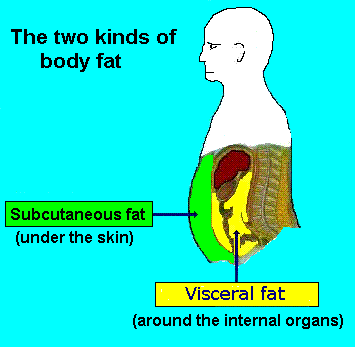 Two studies presented at the recently concluded 1st International Congress on Abdominal Obesity in Hong Kong show that overweight and obese people using orlistat 60 mg with a reduced calorie, lower-fat diet can significantly reduce weight, visceral fat, and waist circumference and therefore may reduce their risk of type 2 diabetes, hypertension, heart disease and stroke (1).
Two studies presented at the recently concluded 1st International Congress on Abdominal Obesity in Hong Kong show that overweight and obese people using orlistat 60 mg with a reduced calorie, lower-fat diet can significantly reduce weight, visceral fat, and waist circumference and therefore may reduce their risk of type 2 diabetes, hypertension, heart disease and stroke (1). In the three-month randomized placebo controlled Visceral Fat Imaging Study (2) trial 26 overweight and obese subjects took orlistat 60 mg 3 times a day and ate a hypocaloric (reduced by 500 kcal) low-fat diet.
Subjects received a single dietary counseling session, and an abdominal magnetic resonance imaging (MRI) scan was performed to measure visceral adipose tissue (VAT) at baseline.
By showing changes taking place inside people's bodies MRI measures fat more accurately than weight or waist measurement.
After 12 weeks, the Visceral Fat Imaging Study recorded a significant reduction in body weight, waist circumference, and VAT was recorded, according to MRI. 24 subjects completed the study.
In the six-month Visceral Fat Multi-Center Study (3), overweight and obese adults receiving orlistat while on a reduced calorie, lower-fat diet had significantly greater improvements in visceral fat than those treated with diet alone. 123 participants were randomly assigned to receive either alli three times per day or a placebo, along with recommendations to follow a reduced calorie, lower-fat diet, for 24 weeks.
At week 24, statistically significant reductions in visceral fat and body weight were observed in both groups; however, the reduction was significantly higher among patients taking orlistat.
With an aging population and burgeoning obesity rates among children, the stage is being set for an epidemic of cardiometabolic disease among future generations.
Congress organizers hope to raise awareness of abdominal obesity as a new risk factor that, along with traditional risk factors, can be modified to reduce the risk of serious diseases, such as diabetes, hypertension, high cholesterol and stroke.
- Orlistat works by inhibiting the action of lipases in the lumen of the stomach and small intestine. The inactivated enzymes are thus unavailable to hydrolyze dietary fat into absorbable free fatty acids and monoglycerides. A significant proportion of dietary fat, therefore, remains undigested and unabsorbed, passing through the GI tract unchanged.
- Visceral fat (belly fat) is a dangerous type of fat that surrounds the vital organs in the abdomen and when present in excess disrupts the normal functioning of organs, increasing the risk of life-threatening diseases. Even modest weight loss can result in significant reductions in visceral fat and substantially improve health.
References:
1. CLICK HERE for our earlier post on the Dangers of Belly Fat
2. Beaver J, Bell JD, Thomas EL et al. Orlistat 60 mg in conjunction with diet provides significant reduction in visceral adipose tissue. Poster presented at: 1st International Congress on Abdominal Obesity, 2009, Hong Kong.
3. Greenway F, Smith SR, Murray K et al. Orlistat 60 mg demonstrates a significant reduction in visceral adipose tissue at 24 weeks compared with placebo. Poster presented at: 1st International Congress on Abdominal Obesity, 2009, Hong Kong.
4. Picture : http://i578.photobucket.com


No comments:
Post a Comment